

|
| DEUTSCHLAND | GERMANY |
| Bundesland: Schleswig-Holstein | |
| Stadt: Kiel |
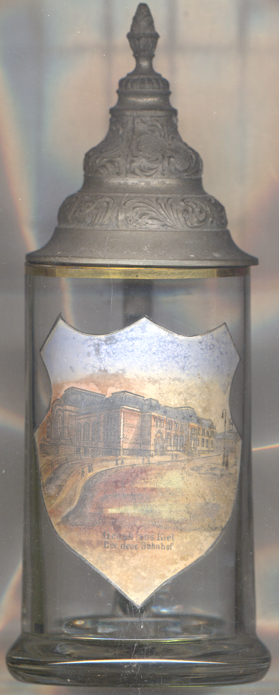 Kiel is situated in the Kieler Förde bay at the northeastern coast of the Baltic Sea region of Schleswig-Holstein.
Kiel was founded between 1233 and 1242 and already in 1242 obtained the status of a town. The history of Kiel always was influenced by its location at the seaside.
By 1431 it had become an important trading place. In 1665, the university of Kiel was founded by Duke Christian Albrecht of Schleswig-Holstein-Gottorf.
When the line Schleswig-Holstein-Gottorf became extinct in 1702, the small country was reunited with the elder line of the house of Schleswig, the Kings of Denmark.
A first canal (34 km) was built in 1777–1784 between Kiel and the river Eider at Rendsburg in central Schleswig.
In 1864, Schleswig with Kiel became a Prussian province. In 1871, the year of the foundation of the German Empire,
the harbour of Kiel became the central port of the German Navy. Its strategic importance was further enhanced in 1895 by the opening of the Kiel canal (Nord-Ostsee-Kanal),
which allowed large ships to reach the North Sea without having to enter Danish waters and to circumnavigate the Danish peninsula.
After World War I, the German Revolution of 1918, which lead to the Weimar Republic, took its beginning in Kiel.
Since 1946, Kiel is the capital of Germany's state of Schleswig-Holstein.
Kiel is situated in the Kieler Förde bay at the northeastern coast of the Baltic Sea region of Schleswig-Holstein.
Kiel was founded between 1233 and 1242 and already in 1242 obtained the status of a town. The history of Kiel always was influenced by its location at the seaside.
By 1431 it had become an important trading place. In 1665, the university of Kiel was founded by Duke Christian Albrecht of Schleswig-Holstein-Gottorf.
When the line Schleswig-Holstein-Gottorf became extinct in 1702, the small country was reunited with the elder line of the house of Schleswig, the Kings of Denmark.
A first canal (34 km) was built in 1777–1784 between Kiel and the river Eider at Rendsburg in central Schleswig.
In 1864, Schleswig with Kiel became a Prussian province. In 1871, the year of the foundation of the German Empire,
the harbour of Kiel became the central port of the German Navy. Its strategic importance was further enhanced in 1895 by the opening of the Kiel canal (Nord-Ostsee-Kanal),
which allowed large ships to reach the North Sea without having to enter Danish waters and to circumnavigate the Danish peninsula.
After World War I, the German Revolution of 1918, which lead to the Weimar Republic, took its beginning in Kiel.
Since 1946, Kiel is the capital of Germany's state of Schleswig-Holstein.
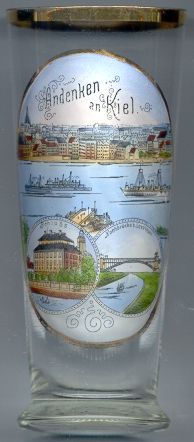
 Kiel castle [left, no. 1476: bottom left]
goes back to a castle that was built by Duke Friedrich I of Holstein-Gottorf in 1512 on the site of an earlier, medieval castle.
In 1558–1568 the castle was extended by a splendid residence in Renaissance style.
In 1697 a further extension was erected in Baroque style. The ornate Renaissance roofs
had become derelict by the 18th century and were replaced in 1763 by the roof shown on the glass.
During World War II the castle was destroyed, only the west wing remained. A modern building
was erected on the site of the old castle in 1961–1963. Until 2002 the building was home of the
state library of Schleswig-Holstein and other state offices. The culture centre "Kieler Schloss" was privatized in 2003.
Annually there are about 300 events with more than 200,000 guests taking place here.
Kiel castle [left, no. 1476: bottom left]
goes back to a castle that was built by Duke Friedrich I of Holstein-Gottorf in 1512 on the site of an earlier, medieval castle.
In 1558–1568 the castle was extended by a splendid residence in Renaissance style.
In 1697 a further extension was erected in Baroque style. The ornate Renaissance roofs
had become derelict by the 18th century and were replaced in 1763 by the roof shown on the glass.
During World War II the castle was destroyed, only the west wing remained. A modern building
was erected on the site of the old castle in 1961–1963. Until 2002 the building was home of the
state library of Schleswig-Holstein and other state offices. The culture centre "Kieler Schloss" was privatized in 2003.
Annually there are about 300 events with more than 200,000 guests taking place here.
The picture on glass no. 3218 [right, no. 3218] shows a view of the
 'New Station
'New Station
[https://en.wikipedia.org/wiki/Kiel_Hauptbahnhof]
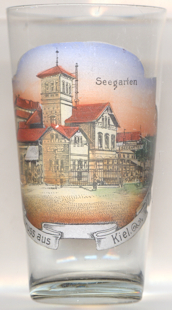
 Seegarten is the name of the area at the height of Kiel Castle between the Kiel Maritime Museum and Ostseekai
on the Kiel Fjord. The park area was laid out in 1889. The building depicted on glass no. 4678 [near left] is the
restaurant and music pavillon, which opened in the ame year.
Seegarten is the name of the area at the height of Kiel Castle between the Kiel Maritime Museum and Ostseekai
on the Kiel Fjord. The park area was laid out in 1889. The building depicted on glass no. 4678 [near left] is the
restaurant and music pavillon, which opened in the ame year.
[https://kiel-wiki.de/Seegarten]
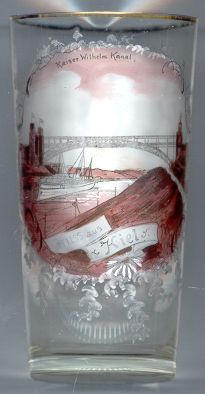
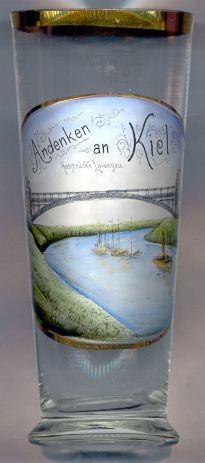
The  Nord-Ostsee-Kanal (Kiel canal)
was constructed between 1887 and 1895. The canal (100 km) connects Kiel with Brunsbüttel at the mouth of the river Elbe.
One of the strategic necessities was the acquisition of the island of Helgoland in the German Bight,
which was in possession of England. The Helgoland–Zanzibar Treaty of 1890 finally secured the island for Germany.
The canal was formally opened in 1895 by Emperor Wilhelm II and was named Kaiser-Wilhelm-Kanal in honour of his grandfather
Wilhelm I, the first German emperor. The larger warships made it necessary to broaden and deepen the canal in 1907–1914.
After World War I, the Treaty of Paris (Versailles) declared the canal an international waterway.
The name was changed to 'Nord-Ostsee-Kanal' in 1946. The canal was widened again in 1961.
Nord-Ostsee-Kanal (Kiel canal)
was constructed between 1887 and 1895. The canal (100 km) connects Kiel with Brunsbüttel at the mouth of the river Elbe.
One of the strategic necessities was the acquisition of the island of Helgoland in the German Bight,
which was in possession of England. The Helgoland–Zanzibar Treaty of 1890 finally secured the island for Germany.
The canal was formally opened in 1895 by Emperor Wilhelm II and was named Kaiser-Wilhelm-Kanal in honour of his grandfather
Wilhelm I, the first German emperor. The larger warships made it necessary to broaden and deepen the canal in 1907–1914.
After World War I, the Treaty of Paris (Versailles) declared the canal an international waterway.
The name was changed to 'Nord-Ostsee-Kanal' in 1946. The canal was widened again in 1961.
The  high bridge at Levensau was completed in 1895.
Its mean height is 40 m, the span is 163 m. The bridge was considerably altered in 1954.
high bridge at Levensau was completed in 1895.
Its mean height is 40 m, the span is 163 m. The bridge was considerably altered in 1954.
The picture on glass no. 2017 [right] is erroneously labeled Hochbrücke Lavensau instead of Levensau.
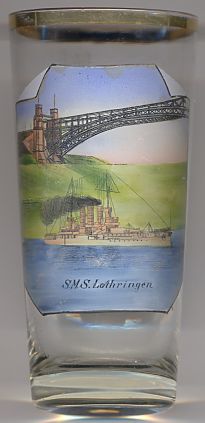
Glass no. 2150 [left] shows the shows the battleship
 SMS Lothringen.
SMS Lothringen.
Several glasses of this collection show other ships.
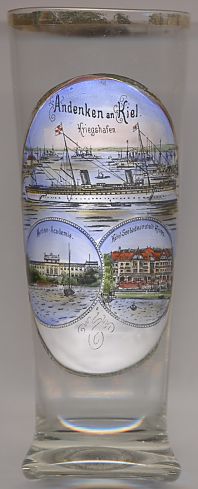
The top picture on glass no. 2123 [near left] shows a view of the
 Navy
Navy
The  Naval Academy [bottom left picture]
was built in 1888 for the Imperial Navy. From 1919 until 1945 it was the seat of the Commanding Admiral for the Baltic Sea.
In World War II the building was damaged and had to be restored. Since 1950 the building is the seat of the Parliament
of Germany's state of Schleswig-Holstein (Landeshaus). At present, it houses the state's parliament (Landtag),
parts of the state chancellery (Staatskanzlei) and an office of the Prime Minister of Schleswig-Holstein.
Naval Academy [bottom left picture]
was built in 1888 for the Imperial Navy. From 1919 until 1945 it was the seat of the Commanding Admiral for the Baltic Sea.
In World War II the building was damaged and had to be restored. Since 1950 the building is the seat of the Parliament
of Germany's state of Schleswig-Holstein (Landeshaus). At present, it houses the state's parliament (Landtag),
parts of the state chancellery (Staatskanzlei) and an office of the Prime Minister of Schleswig-Holstein.
The  Hotel Seebadeanstalt Krupp [bottom right picture]
was opened in 1900 and until 1919 was owned by the Krupp family from Essen.
In 1919, the family donated the building to the university of Kiel and the hotel was converted to the Institute for
Maritime Traffic and World Economy (today Kiel Institute for World Economy).
Hotel Seebadeanstalt Krupp [bottom right picture]
was opened in 1900 and until 1919 was owned by the Krupp family from Essen.
In 1919, the family donated the building to the university of Kiel and the hotel was converted to the Institute for
Maritime Traffic and World Economy (today Kiel Institute for World Economy).
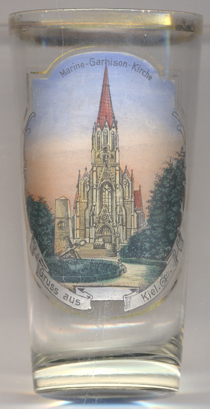
The  Pauluskirche (St. Paul's Church) [left, no. 3217]
in Kiel's borough of Düsternbrook was built in 1878–1882 in Gothic revival style as the garrison church
for the Prussian Navy at Kiel. Due to its elevated location about 30 m above sea-level, it also served
as a landmark for ships on the Innenförde. The spire until today is the highest church tower (72 m) of Kiel.
The Navy used the church until 1918; since then, it is used by the Lutheran parish Heiligengeist. The church was
damaged in World War II, but it was restored provisionally in 1948; a more through renovation took place
in 1957–1960.
[https://de.wikipedia.org/wiki/Pauluskirche_(Kiel)]
Pauluskirche (St. Paul's Church) [left, no. 3217]
in Kiel's borough of Düsternbrook was built in 1878–1882 in Gothic revival style as the garrison church
for the Prussian Navy at Kiel. Due to its elevated location about 30 m above sea-level, it also served
as a landmark for ships on the Innenförde. The spire until today is the highest church tower (72 m) of Kiel.
The Navy used the church until 1918; since then, it is used by the Lutheran parish Heiligengeist. The church was
damaged in World War II, but it was restored provisionally in 1948; a more through renovation took place
in 1957–1960.
[https://de.wikipedia.org/wiki/Pauluskirche_(Kiel)]
![[scale]](lineal.jpg)